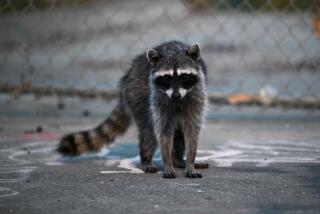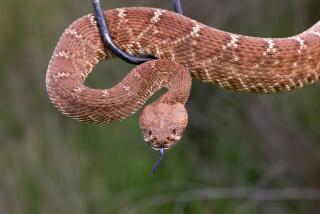Preemptive Approach to Combatting Rabies : Facing the worst epidemic ever, New Jersey officials are using vaccine-laced bait to immunize animals.
- Share via
NEW YORK — A helicopter swooped low over southern New Jersey recently on a unique search-and-destroy mission. Its target: rabies.
The chopper hovered over marshes and woods as a biologist searched for signs signaling the presence of wild raccoons. When a fertile area was found, special fish meal baits were dropped. Embedded in each tasty morsel was a wax vial filled with anti-rabies vaccine. When the hungry raccoons chomped the bait, they also bit through the vial and received a dose of vaccine.
The aim of the experiment was to immunize the animals and create a rabies-free zone in the Garden State. The program comes as one of the worst rabies epidemics in recent history moves up the Atlantic Coast. While no people have died, thousands have had to undergo costly anti-rabies treatments, public health laboratories have been swamped conducting tests and untold numbers of animals--mostly raccoons--have died.
Since 1990, the number of reported cases of animal rabies has increased 43% in the United States--largely due to the East Coast epidemic. Rabies deaths among humans in the United States are rare because of the prevalence of anti-rabies serum.
In New Jersey alone, about 2,137 rabid animals have been diagnosed since November, 1989. It is estimated that more than 2,000 people so far have received anti-rabies inoculations.
“This is the worst epidemic we have seen ever in New Jersey’s recorded rabies history,” said Dr. Faye Sorhage, the state’s public health veterinarian.
In New York, which leads the nation in animal rabies, the Department of Environmental Conservation took the unusual step of issuing special public warnings at the start of the deer hunting season on Nov. 16.
Cautioning that foxes, raccoons, skunks, bats and woodchucks may be carrying the disease, DEC Commissioner Thomas Jorling urged that hunters become familiar with its signs--animals that appear overly aggressive or drunk and disoriented. He recommended that hunters wear disposable plastic gloves while handling carcasses and avoid touching animals that have died of unknown causes.
State Health Department officials predicted that more than 1,600 animals would be confirmed rabid through laboratory tests in New York state this year--the highest number since records began in 1925. Health officials said more than 900 people needed anti-rabies vaccine in 1991. Estimates are that the number will rise to more than 1,400 in 1992.
“We have a lot of people whose pets were bitten by a sick animal and they get saliva on their hands,” said Vicki Zeldin, a spokeswoman for the Department of Health. Since “most of us have a torn cuticle or a cut,” she added, “they are recommended to get post-exposure treatment.”
In California, health officials estimate one out of every four skunks tests positive for rabies, as does one in 10 bats.
“One of the worst things about it is the stages you go through before you die,” said Dr. Larry Barrett, California’s state veterinarian for public health.
In humans, the virus has an affinity for the central nervous system, leading to uncontrollable excitement, excessive salivation, excruciatingly painful spasms of the muscles controlling the larynx and pharynx and eventual death in most cases from asphyxiation, exhaustion or paralysis.
Prompt administration of anti-rabies shots, which cost about $1,000, provides immunization and prevents the disease. The good news is that the injections, which used to be given in the stomach, are now less painful and are given in the arm.
According to the U.S. Public Health Service’s National Center for Infectious Diseases, rabies probably was introduced to the mid-Atlantic region in the mid-1970s when rabid raccoons were unknowingly transported to the area from Florida for hunting. The disease now has spread up the coast, as far as New England.
Several experiments are under way to try to stop the spread. Wildlife officials, borrowing biotechnology that is leading to the elimination of fox rabies in Belgium, dropped vaccine-laced baits for raccoons over woods and marshes in a 200-square-mile area of southern New Jersey in April and again in October.
“There has not been any rabies in the barrier,” said Dr. Charles E. Rupprecht of Thomas Jefferson University Medical School in Philadelphia. “We are keeping our fingers crossed.”
Rabies on the Roam
Raccoon rabies has become an increasingly important problem in the East. In 1991, 3,079 cases of rabies in raccoons were reported, the largest number in the history of animal surveillance in the United States. Highlights from a recent report:
Connecticut: Raccoon rabies first detected in March, 1991. . . . Cases have now been confirmed from 64 of Connecticut’s 169 cities.
New Jersey: First detected in November, 1989. . . . most cases since 1989 have occurred in raccoons (1565), followed by skunks (192); cats (57); groundhogs (41); foxes (14); deer (five); domestic rabbits (four); cattle (three); sheep (two); opossums (two); beaver (one); black bear (one), and horse (one).
New York: First detected in the summer of 1990 and now extends on a 350-mile front involving 24 counties of southern New York. . . . In 1991, 666 raccoons were confirmed rabid. . . . During the first half of 1992, 589 rabies treatments were administered, a 60% increase over the same period in 1991.
North Carolina: First rabid raccoon found on June 18, 1991, in a county bordering Virginia. . . . Through July 31, 1991, five raccoons and four foxes were confirmed rabid in two neighboring south-central counties, including the Charlotte metropolitan area, representing the first extension of rabies into a major population center of North Carolina.
Ohio: In state’s first documented case, rabies confirmed last March in a raccoon from Martins Ferry in Belmont County. . . . Martins Ferry borders the Ohio River across from Marshall County, West Virginia, where a dog was found to have the raccoon rabies strain in June, 1990.
Source: Centers for Disease Control
More to Read
Sign up for Essential California
The most important California stories and recommendations in your inbox every morning.
You may occasionally receive promotional content from the Los Angeles Times.










